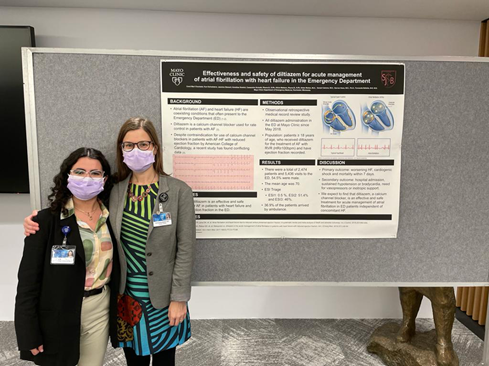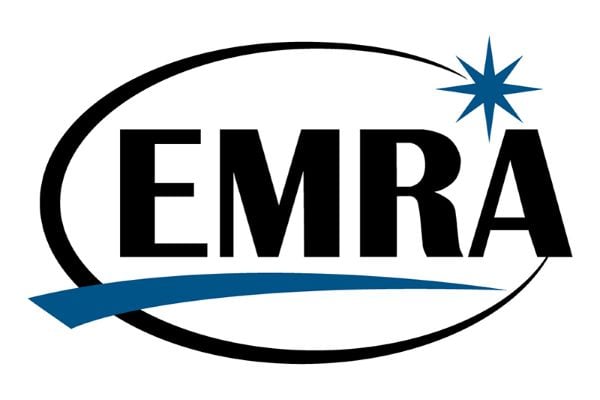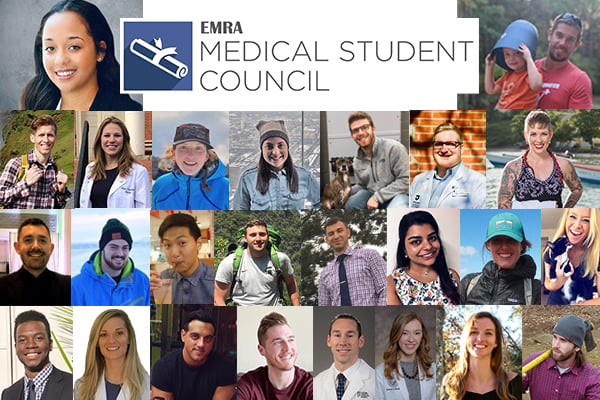Summer Research: Emergency Department @Mayo Clinic Rochester, Minnesota
Coral Marí Chantada, MSII
San Juan Bautista School of Medicine in Puerto Rico
It gives me great excitement to share with you my summer research experience at the Emergency Department (ED) at Mayo Clinic College of Medicine — a Level 1 Trauma Center in Rochester, Minnesota — where ambulances and helicopters are constantly coming in and out with patients and filled with healthcare professionals who are prepared at a moment's notice to help for any level of emergency. During my first year of medical school, I applied to the Summer Research Fellowship (SRF) 2022 program, and when I was informed of my acceptance the Spring before the program’s start, I did not think twice about accepting: I immediately confirmed my participation! Dr. Fernanda Bellolio, Professor of Emergency Medicine, Consultant at the Department of Emergency Medicine, and Chair for Research for the ED, with numerous other professional achievements, was my mentor. She was my guide both in the research and clinical areas, while I explored the ED at Mayo Clinic this past summer. I am beyond grateful to have had the opportunity of working with such an insightful and astounding mentor!
Summer Research Fellowship @Mayo Clinic — Rochester, Minnesota
Mayo Clinic College of Medicine and Science's SRF program wants to "address the need for clinical investigators from diverse backgrounds"[1]. "Health needs of U.S. minority populations have been studied inadequately, due in part to the shortage of clinical investigators belonging to underrepresented groups”[1]. Mayo Clinic’s goal is to increase the number of students interested in clinical research from diverse backgrounds to promote diversity and representation in the field of medicine across many specialties, while also motivating students to work towards closing the gap that exists in the scientific literature regarding underrepresented minorities. The experience motivated me to incorporate research into my career as a future physician and work towards giving a voice to groups that are underrepresented in medicine to find out how we can help them more efficiently with all their health needs. I am Latina — born and raised in Puerto Rico — and I recently read a statistic about the number of Latino doctors making up only 6% of practicing physicians. As highlighted on National Latino Physicians Day, on October 1st, "6% is not enough." As future physicians, we should strive to close that gap that exists in healthcare for ALL minority populations and underrepresented groups. I feel lucky to have been able to participate in a research program focused on promoting diversity and to have had the opportunity to connect with medical students from diverse backgrounds interested in the same. I was surrounded by healthcare professionals who provided opportunities and spaces of learning and development for students interested in clinical research from diverse backgrounds.
During the summer, I was able to see how Dr. Bellolio was able to balance her career in terms of clinical practice, research, and personal life . The phrase that resonated with me the most this past summer was one by Benjamin Franklin who said: “Tell me and I forget, teach me and I may remember, involve me and I learn.” The best way to learn is by being actively involved in real-life experiences, and I do not doubt that for a second after the learning I participated in during my summer research experience. After finishing my first year of medical school, which consisted of long hours of studying and adaptation, having the opportunity to enter the field of clinical research, while also being able to shadow in the ED, made a lot of what I learned that first year of medicine click. It helped me nail down that information in my head.
Clinical Research at the ED
While performing clinical research, I worked together with my mentor and an interdisciplinary team in an investigation that focused on studying: the "Effectiveness and safety of diltiazem for acute management of atrial fibrillation (AF) in patients with heart failure (HF) and reduced ejection fraction in the Emergency Department." The study aimed to evaluate if diltiazem is an effective and safe treatment for AF in patients with HF and reduced ejection fraction coming into the ED. I had the opportunity to start this chart review project from scratch. As soon as I arrived at Mayo Clinic at the end of May, I met the entire ED team and started with the literature review to create a research proposal with the help of Dr. Bellolio and the team. The literature review allowed me to put to use everything learned in my first year of medical school and was able to formulate possible questions around which to center a research project. Once I completed the literature review, I started with the IRB proposal so we could obtain the necessary permissions to carry out the study. Both conducting the literature review and writing the IRB proposal with guidance from my mentor in the first few days of the program allowed me to see what it would be like to be a physician who performs clinical research — which was incredibly motivating. Additionally, this summer experience has made me want to become a physician who spends time mentoring students in the research process. During my weeks in the ED, I had a perfect combination of tasks. I worked with the ED research team on other projects while the IRB proposal was in the process of approval. In the meantime, I also continued my search for scientific papers related to my primary project and started preparing a manuscript while attending the ED weekly Grand Rounds which talked about everything from how to care for and treat patients who were breastfeeding in the ED to the battle between Rapid Sequence Intubation (RSI) agents used in the ED. We also had weekly seminars given by my mentor and other ED consultants where they discussed the different types of research projects one could engage in as a physician who performs research, to how to write a manuscript that would be successful in the publication process. The SRF program also had weekly seminars where clinical researchers talked about their professional journeys and current projects. All while this was going on, I was shadowing and saw patients arriving with different medical issues as well as traumas. Once the IRB approval for my project finally arrived, my team started the critical task of chart review for our patients! On my last day of the SRF program, I had the opportunity to present my research project twice, in the Emergency Department and at the Poster Presentation at Mayo Clinic along with the other SRF students. It was a great end to such an unforgettable experience! Currently, the project is in the data abstraction phase; I am very excited to be able to soon see the final results.
I did it! Lessons learned
Thanks to my Summer Research Fellowship at Mayo Clinic, I created countless professional and personal connections that are of great value to me. Everyone made me feel right at home and I counted on the necessary guidance to achieve my professional and research goals during my time there. I left the ED at Mayo Clinic Rochester, Minnesota having seen my first patient with a "caput medusae" — portal hypertension, stroke, and AF among many other medical conditions. I was able to see how ED consultants and numerous other ED healthcare professionals prepare for incoming traumas. I witnessed the level of focus and analysis they achieve in a short amount of time to make sure every patient is properly taken care of within the sensitive timeframe. Gaining the trust of a patient quickly in a very fearful and vulnerable moment, as is the case with most patients who come to the ED, is one of the greatest lessons I learned. Observing closely how the physician-patient interaction in emergent moments is key to making them feel safe and calm. I strive to become a physician who gives comfort and tranquility to each patient that I care for, and I am grateful for the opportunity I had at Mayo Clinic. I hope my experience motivates others to take the necessary steps to achieve whatever it is they want in their professional careers, because the opportunities are there, and we have to just go for them.
References:
1. Mayo Clinic College of Medicine and Science. Summer research fellowship - residencies and Fellowships - Mayo Clinic College of Medicine & Science. Mayo Clinic College of Medicine and Science. https://college.mayo.edu/academics/residencies-and-fellowships/summer-research-fellowship/.







